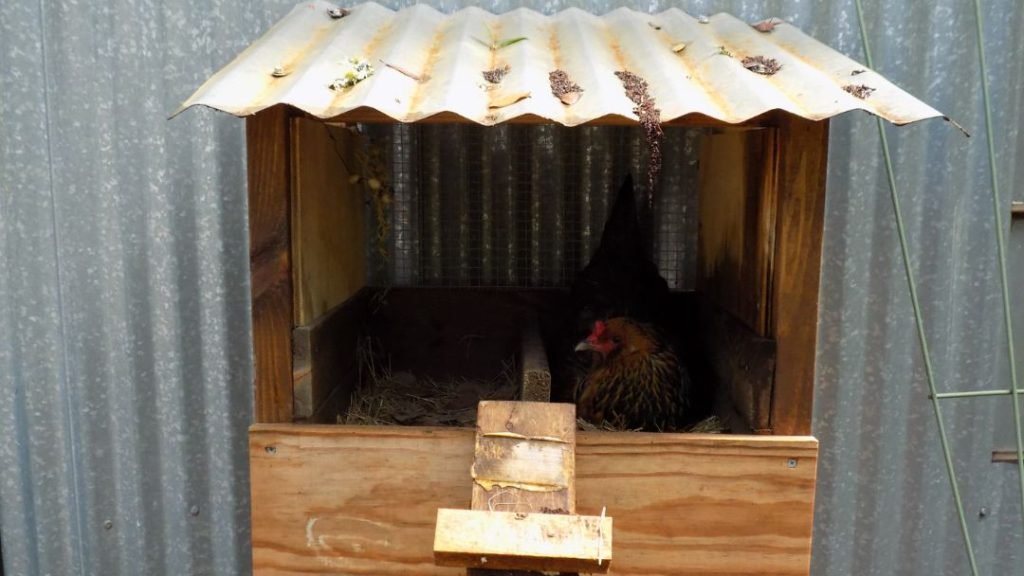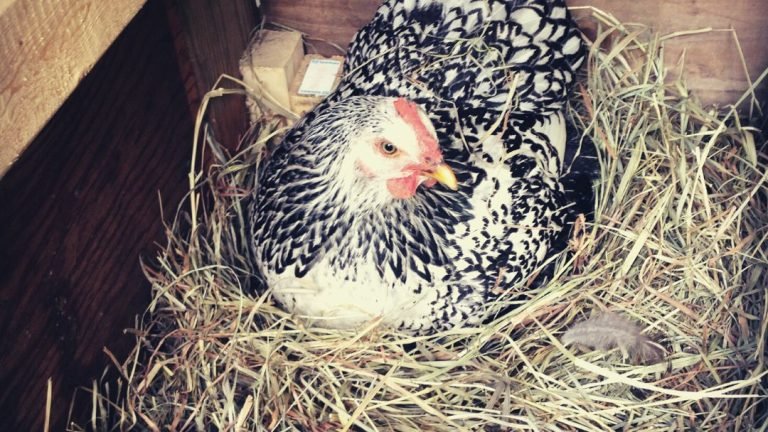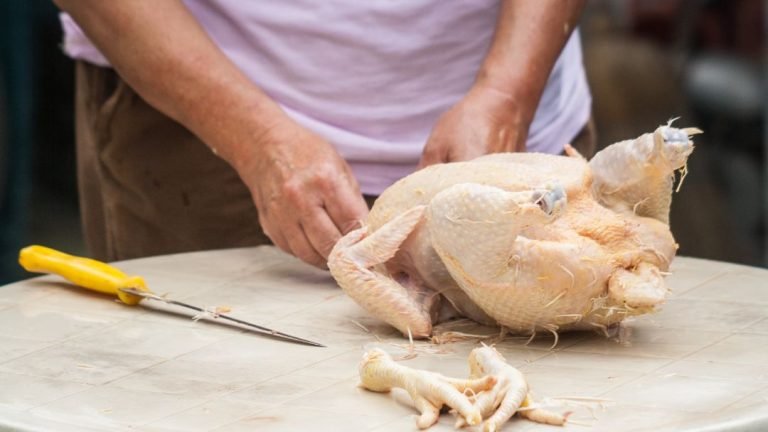Nesting boxes are necessary to help chickens lay eggs more comfortably and collect eggs effortlessly. But do you have any idea where to put chicken nesting boxes? Finding the optimal place to put nesting boxes in the chicken coop is vital.
Keeping nesting boxes 18 to 20 inches away from the ground is a solid rule of thumb. Plus, put them opposite the roosting bars in a lower position. The place should be dark, quiet, safe, and less crowded to let chickens lay eggs peacefully.
Where To Put Chicken Nesting Boxes?
Chicken nesting boxes should be placed in a safe, clean, and quiet environment to let chickens lay eggs conveniently.
There should be around 18-20 inches of distance between the ground and where you want to put the bird boxes.
Keeping the nesting boxes away from the feeder and waterer is a solid rule of thumb.
In addition, you want to select a perfect path where you have to walk less to collect eggs. Apart from saving time, it will help you not disturb hens while laying eggs.

Where To Position Chicken Nesting Boxes?
Your nesting boxes should be faced in a particular direction to ensure optimal comfort.
Most chicken keepers prefer to keep the nesting boxes facing between north and east.
It will keep chickens safe from extreme sunlight, wettest winds, and heavy rains.
You can set them tilted marginally forward if installed outside the chicken coop. This will clear the rain from the entrance area.
Factors To Remember When Placing The Nesting Boxes
A proper plan is a must when setting up the nesting boxes.
Selecting the best location is vital to give your flocks more comfort.
The following are the most important factors you should not overlook to put nesting boxes in a particular place.
01. Nesting Boxes Should Be Lower Than Roosting Bars
Chickens generally prefer the highest area for roosting.
If you set up the nesting boxes higher than the roosting bars, they will start sleeping on them.
If the bird boxes have any roof, they will take them as roosting bars and regularly sleep there.
Flocks poop a little while roosting. You can imagine how messy it will be to clean the boxes.
02. Nesting Boxes Should Not Be Immediately Under Roosting Bars
Some chicken keepers install nesting boxes immediately below the roosting bars.
It can be a huge problem. The bird boxes will be full of chicken droppings.
Hens may refuse to lay eggs on such dirty boxes. They may lay eggs somewhere else.
It is a solid rule of thumb to install nesting boxes on the opposite wall of the roosting bars.
03. Nesting Boxes Should Be Under The Dropping Boards
Some new chicken keepers install dropping boards under the nesting boxes.
They think they will also collect chicken manure when flocks sit inside the nesting boxes.
But it causes more hassles. If they are just below the roosting bars, all the droppings will be on the nesting boxes.
Even if bird boxes are away from the roosting bars, some spitting of chicken poop will make them dirty.
Adding dropping boards over the nesting boxes appears more practical. It will collect all chicken droppings and keep the nesting boxes clean.
04. Nesting Boxes Should Not Be Close To The Windows
Are you planning to install nesting boxes close to the chicken coop windows?
It is a solid rule of thumb to put bird boxes on the opposite wall of the windows.
You can save your flocks from direct sunlight and cool air. Plus, it allows you to create a dimmer condition.
Many experts often recommended setting up nesting boxes in the dimmest area of the coop.
05. Nesting Boxes Should Have An Easy Entrance
The nesting boxes should not have any clutter. Their flight path should be fully clear.
They prefer to land inside the nesting boxes after stepping onto the nesting boxes.
The opening area should be wide enough to accommodate their whole body effortlessly.
If there is any stoppage, it may discourage them from regularly laying eggs inside the chicken coop.
Make sure to unlock the nesting boxes very early morning daily if the boxes have any locking system.
Should You Put The Nesting Boxes Inside Or Outside The Coop?
You can choose both internal and external nesting boxes. Both have pros and cons.
It often depends on your chicken coop size and other factors you give more priority to.
When Should You Put Nesting Boxes Inside The Coop?
The main advantage of internal nesting boxes is providing a darker and quieter space to lay eggs comfortably.
Chickens won’t have to come out during the bad weather to lay eggs.
Besides, predators are likely to break or eat their eggs as eggs are inside the chicken coop.
In addition, chicken keepers don’t need too much preparation to add nesting boxes, unlike outside environments.
When Should You Put Nesting Boxes Outside The Coop?
One of the main advantages of keeping nesting boxes outside the coop is saving space. It comes in handy when you have a small coop.
You can even install larger chicken nesting boxes due to open space. But it will take a little bit of extra preparation.
Chickens will have more interior space to wander around when the weather is bad.
Do you regularly clean your chicken coop? Even if you do, they smell a lot. Putting bird boxes outside will save you from enduring the annoying odor.
Do you like to crawl while retrieving eggs from your flock house? External nesting boxes outside will save you from this hassle.
Do Chicken Nesting Boxes Need To Be Elevated?
Many new chicken keepers often ask this question: Can chicken nesting boxes be on the ground?
As mentioned earlier, nesting boxes should be around 18-20 inches chicken nesting box height from the floor.
If there is a noticeable gap between the coop floor and the main ground, keeping the nesting boxes a few feet off the ground won’t be a problem.
Why should chicken nesting boxes be off the ground? Hens usually prefer an elevated space for laying eggs.
Many chicken keepers shared that their hens chose the top boxes over the bottom ones.
Another advantage of elevated nesting boxes is that predators and pets are less likely to access the box easily. It will keep the eggs safe.
More importantly, elevated chicken boxes make the floor space open. You can utilize the floor space for keeping chicken feeders and water or other purposes.
Aside from that, it will keep the nesting boxes clean due to the minimal collection of debris from the coop floor.
What Problems Can Chickens Face If The Nesting Boxes In The Ground?
Flocks will face these common problems if their nesting boxes are placed on the ground or coop floor.
- It will make the boxes more dirty and smelly.
- Predators like snakes may sit on it.
- Smaller chickens may easily enter the boxes and break the eggs.
- Hens will feel less secure to lay eggs peacefully.
- Chickens are less likely to hatch eggs due to crowded spaces.
- Hens won’t have enough privacy.
- Aggressive roosters may attack and hurt hens.
- Hens may lay eggs somewhere else.
How To Decorate Your Nesting Boxes?
Ever wondered about adding a little decoration to your nesting boxes? We know very few chickens care about it. But it can be beneficial, though.
You can add a small curtain for each compartment of the nesting box. It will help create a darker and more private area for hens.
Flocks may find it more appealing to lay eggs. Plus, it will prevent the cool exterior air from getting inside it.
Another decoration could be adding a few fresh herbs. You can use calendula, basil, borage, cilantro, dandelion, chamomile, etc.
They will add a beautiful smell and provide a little “chicken aromatherapy to attract them.
Marigold flowers come in handy to add a colorful appearance. Besides, this flower is healthy because it contains powerful antioxidants that can fight against various diseases.
How To Put A Chicken Nesting Boxes?
Follow these easy steps to put the nesting box:
Step 01: Select a perfect location inside or outside the chicken coop.
Step 02: Count how many hens you have in the chicken coop. You will need to add two or three extra for future requirements.
Step 03: Buy or make DIY nesting boxes depending on your preference.
Step 04: Put a mark off the ground 18 to 20 inches above. If the chicken coop ceiling is high enough, the height can be 2 to 3 feet.
Step 05: Install the nesting boxes one by one. Make sure to maintain a minimal space between them to avoid cluttering them.
Step 06: Add a small amount of nesting materials to make the boxes comfortable and attractive.
Step 07: Train your hens on how to use the nesting boxes to lay eggs.
Summing Up
Now you know where to put chicken nesting boxes. Proper placement of the nesting boxes is a must to create a perfect environment for laying eggs.
Depending on your preference, you can keep the nesting boxes inside or outside the chicken coop. But if there are any dangerous predators, internal nesting boxes are better.
Make sure to regularly clean your nesting boxes because hens hate dirty bird boxes, especially laying eggs. They may lay eggs elsewhere if you don’t change the bedding material on time.







